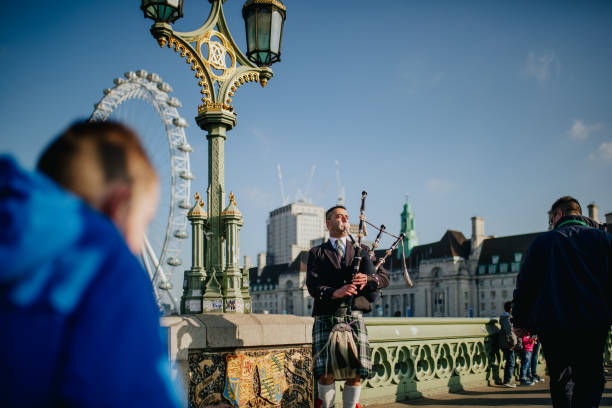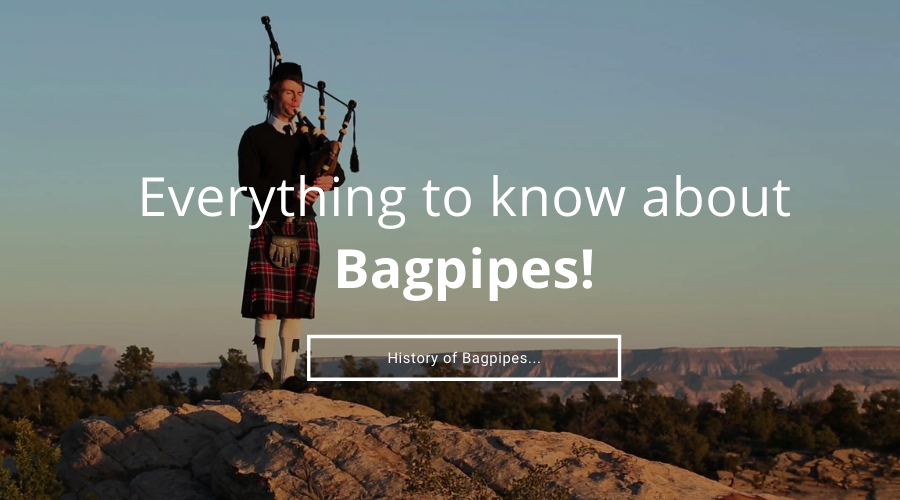There is a strong sense of feelings and memories associated with the wail of bagpipes. They are the emotional background of many events and gatherings which bring back lots of memories associated with the music of it.
Bagpipe which is a Gaelic for “piob-Mhor” (the great pipe) has its origin in Scotland and in the Middle East which then evolved in Europe. There is a lot of history attached to this instrument. A bagpiper plays the bagpipe wearing a men’s kilt along with a Scottish Jacket, Hat, and boots. In order to talk more about the history and origin of Bagpipes, I am sharing this blog post with you.
Table of Contents
All About Bagpipes
History of Bagpipes
Now lets talk about the real history of Bagpipes right away.
Beginning of Bagpipes
There are few evidence that Ancient Egypt has which proves that bagpipes were originated from early 400 BC. There were ‘pipers of Thebes’ blowing pipes that were made up of dog skin with bone chanters.
The early ‘Dudel-Sack’ helped in giving rise to several European, Asian, and African fold bagpipes. There are various bagpipes that are developed around the world with different names and variations. I have listed some of the below names and variations below for you.
- The Piob Mhor, or the Great Highland Bagpipes (Scotland)
- Volynka (U.S.S.R.)
- Bock (Austria)
- Dudelsack (Germany)
- Zukra (North Africa)
- Gaita (Portugal and Spain)
- Zampogna (Italy)
- Cornemuse or Biniou (France)
- Moshug (India)
- Magyar Duda (Hungary)
- Koza (Poland)
- Zampogna (Italy)
- Ney anban (Iran)
- Zokra (Libya)
- Mizwad (Tunisia)
- Zumarah (Egypt)
- Pijpzak (Netherlands)
- Uilleann (Ireland)
- Sackpipa (Scandinavian)
- Dudas (Latvia and Lithuania)
- Sakkipilli (Finland)
- Cimpoi (Romania)
- Ghaita (Algeria)
As you can see that there are various bagpipes and its types were brought to the world. However, the basic constructions for all were almost the same. There were an air supply, a bag with a chanter, and one or more drones (although there were some droneless bagpipes).
Parts of Bagpipe
As I have discussed that there were some common parts which include; an air supply, an air supply, a bag along with a chanter, and one or more drones. Now let’s discuss what actually are.
Air Supply
The Air Supply is the most basic part of a bagpipe and it is provided via the blow stick that is created using various hardwood. The blow stick has been evolved with time that helps in getting more into the bag with less efforts.
The Bag
Earlier, the bag used to made of animal skin which then evolved to be made up of synthetic material. The bag is an important element of a bagpipe that holds and control the air flow of the bagpipe. The bag helps the piper to breath and keep the continuous sound with bagpipes without pauses.
The Drone & the Chanter
Usually, a bagpipe comes with three drones. You may see a bagpipe with 5 pipes; three of these 5 pipes are drones. The longest pipe is the bass drone (it produces the lowest tone), and the two same size pipes are the tenor drones. The remaining two pipes are the chanter and the blow stick.
The reed that is given at the top produces notes from the chanter. A chanter may look like a whistle or a wooden recorder. You play whistles and recorders from blowing directly using your mouth. A bagpipe is played using the air collected in the bag.
A great highland bagpipe is considered as the woodwind instrument like the bassoon, oboe, and clarinet.
The reeds of a bagpipe are usually closed inside the wooden “stocks”. A great highland bagpipe has four reeds which are namely: the chanter reed (double), two tenor drone reeds (single), and one bass drone reed (single).
Bagpipes in Wars
Normally, a bagpipe is a musical instrument; however, it used to be played in wars as well. In the 1549 Battle of Pinkie, bagpipes’ playing was replaced with trumpets that helped in summoning and rouse the highlander in battle. The sound of bagpipes used to be heard till 10 miles away.
It does not only helps to spread the war cry but also used to produce fear in enemies.
Due to this influence, the bagpipes became the war instruments during the early 1700 Highland uprising and the subsequent defeat of Bonnie Prince Charlie at the Battle of Culoden in 1746. This battle was the reason that the government in London attacks the whole highland’s clan system. They criminalized the bagpipes and also banned wearing kilts.
Where Bagpipes are usually played?
Bagpipes are the part of almost all the ceremonies for the Celts. It is played on various parties, informal and formal occasions. Bagpipers are dressed in traditional outfits along with complementary traditional accessories.
Most commonly, the bagpipe is played on Burns Night where Scottish societies honor Robert Burns with a dinner poem recitations, speech, and a whisky. The bagpipe is also played on this night.
On many Celtic weddings bagpipers play as the bride walks down the aisle and again when newly married couple’s exit.
Bagpipers also lead the funeral processions. They are usually outside the church when mourners enter or leaves the church. They often play at the cemetery as per is laid to rest.
It is also played on birthday parties, St Patrick’s Day, and other special events.
Bagpipes in Modern Times

Bagpipes have been featured in some of the contemporary music like ‘Mull of Kintyre’ by Paul McCartney and A.C.D.C’s. It got very popular on the internet which brought the international acknowledgment of the bagpipes.
Moreover, bagpipes have also become a traditional instrument at military, fire, police, and state funerals.
Conclusion
This was all about Bagpipes that I wanted to share with you. I am sure you guys must have got the clear idea about Bagpipes and its history. If you would like to add your point then feel free to write to us, we will be more than happy to add your points to our post.
